Small Manufacturers Win Big with Digital Transformation

For small and medium-sized manufacturers, digital transformation can seem like an especially harrowing task. But smaller organizations can be uniquely positioned for success in implementing firmwide digital strategies.
Small but mighty: Just look at Graphicast, a 25-person precision metal parts company in Jaffrey, New Hampshire.
- “Because the cost of data collection and analytics is getting lower and lower, even as a small company we can collect data at a rate that gives us meaningful information we can act upon,” said Graphicast President Val Zanchuk. “For example, we created a linear programming model of our business. If we’re growing at a certain rate, I can use it to determine the most economical next steps, such as whether we should hire more people, work overtime or purchase more equipment.”
A workforce solution: Graphicast, which counts Fortune 100 companies among its clientele, has used cloud computing, AI-based systems and more to help it succeed, according to Zanchuk.
- The manufacturer is also looking into the use of collaborative robots as a potential solution to the labor force shortage.
- “When it comes to Manufacturing 4.0, we think about what our customers will be looking for from us in terms of digital collaboration,” said Zanchuk, adding that some of the business’s larger customers are “transforming at a different rate than we are.” That means it’s up to Graphicast to consider client expectations and see how best to meet them given “what’s financially and operationally feasible” for the company.
The MLC helps out: To aid in Graphicast’s digital transformation, Zanchuk joined the Manufacturing Leadership Council, the NAM’s digital transformation division.
- “The MLC is the only place I know where I can discuss broad industry trends in an open fashion, where small companies like mine and large companies like Ford or GM can all be involved in the discussion,” said Zanchuk, who serves on the MLC Board of Governors.
- “Being part of the MLC lets us know if we’re on the right track and how we can make adjustments,” he continued. “It connects us to a group of incredibly talented, intelligent and experienced people who are focused on many of the same operational challenges we face.”
Announcing the 2023 Manufacturing Leadership Award Finalists!

The Manufacturing Leadership Council—the NAM’s digital transformation division—has announced the finalists for the 2023 Manufacturing Leadership Awards, the industry’s premier awards program for achievements in digital manufacturing. You can read the complete list of finalists here.
The ceremony: The finalists will be honored at the Manufacturing Leadership Awards Gala in Marco Island, Florida, on June 28.
- Also announced at the gala will be winners for all project and individual categories, winners of the Manufacturing in 2030 Award, the Manufacturing Leader of the Year, the Small/Medium Enterprise Manufacturer of the Year and the Large Enterprise Manufacturer of the Year.
Rethink: Certain award winners will also present at Rethink, the industry’s leading event for exploring manufacturing’s digital era, which will also take place in Marco Island on June 26–28.
The categories: The awards are divided into nine project categories to recognize company achievements:
- Artificial Intelligence and Machine Learning
- Collaborative Ecosystems
- Digital Network Connectivity
- Digital Supply Chains
- Engineering and Production Technology
- Enterprise Technology Integration
- Operational Excellence
- Sustainability and the Circular Economy
- Transformational Business Cultures
Additionally, individual leaders are recognized in the Digital Transformation Leadership and Next-Generation Leadership categories.
The last word: “As more manufacturers extend digital’s reach onto the factory floor and throughout their operations, we are witnessing transformative performance improvements that would have been unthinkable just a few short years ago—and that are improving life for employees and customers alike,” said MLC Co-Founder, Vice President and Executive Director David R. Brousell.
Manufacturers Add Industry Expert Amid Fight for Permitting and Regulatory Reform
Washington, D.C. – The National Association of Manufacturers has announced Brandon Farris as its new vice president of energy and resources policy.
“Brandon joins the NAM at a pivotal time in our country and for our industry,” said NAM President and CEO Jay Timmons. “Manufacturers across the United States face regulatory challenges that affect their ability to do what they do best: transform and deploy modern technologies to protect the environment, while creating jobs and strengthening the economy. Commonsense regulatory and permitting reform, along with energy security, are needed now more than ever. Brandon’s experience and expertise will help manufacturers accomplish these critical goals.”
Before joining the NAM, Farris was the head of federal government relations for The Chemours Company, where he played an integral role in securing passage of the AIM Act, designed to phase out refrigerants that contribute to climate change. He worked closely with the NAM to help secure bipartisan ratification of the Kigali Amendment to the Montreal Protocol during the 117th Congress. Along with these and other major legislative accomplishments, he was honored as a 2022 top lobbyist by the National Institute for Lobbying & Ethics.
Previously, Farris served as assistant general counsel for Arkema as well as senior counsel for government relations for the Saudi Basic Industries Corporation. After serving in the Marine Corps Reserve, he began his career in Washington as a Bryce Harlow Foundation Fellow at the George Washington University School of Law while working on the U.S. House Agriculture Committee.
-NAM-
The National Association of Manufacturers is the largest manufacturing association in the United States, representing small and large manufacturers in every industrial sector and in all 50 states. Manufacturing employs nearly 13 million men and women, contributes $2.81 trillion to the U.S. economy annually and accounts for 55% of private-sector research and development. The NAM is the powerful voice of the manufacturing community and the leading advocate for a policy agenda that helps manufacturers compete in the global economy and create jobs across the United States. For more information about the NAM or to follow us on Twitter and Facebook, please visit www.nam.org.
New Survey: Manufacturers Want Increased Trade with Europe
New Regulations and Taxes Will Hurt Expansion
London, U.K. – As the National Association of Manufacturers’ Competing to Win Tour begins its second week of bolstering strategic alliances across Europe, the association released findings from its Q1 2023 Manufacturers’ Outlook Survey. The survey found that expanding trading opportunities with Europe is a top priority for manufacturers, with more than 77% of respondents supporting negotiating new agreements with European nations.
“At a time when democracy and free enterprise are under attack from forces around the world, America can provide the leadership needed to defend our values, our institutions and our way of life,” said NAM President and CEO Jay Timmons. “By advancing an ambitious trade agreement agenda, we can ensure that the U.S.—and not competitors like China—writes the rules for the global economy and trading system. That has been the focus of our conversations with government, association and business leaders across Europe over the past week.”
The survey also continues to illustrate the need for Washington to enact policies that support the sector’s competitiveness as businesses face record job openings and increased production and input costs.
“With geopolitical turmoil and a banking crisis injecting further uncertainty into the economy, policymakers must act with urgency on key tax, trade, permitting and regulatory proposals if they want to help manufacturers in America fend off a recession,” said Timmons.
Background: Manufacturers have called on Congress and the White House to address key tax, trade, and permitting policies in recent months and have pressed lawmakers to work across the aisle to move legislation. The NAM conducted the survey from Feb. 21 to March 7, 2023.
Key Findings:
- Of companies that are engaged in international trade, nearly two-thirds of manufacturers said that Europe was either a somewhat or very important market for their company. With that in mind, 77.7% would support U.S. efforts to launch market-opening trade agreement negotiations with countries in Europe.
- Nearly three-quarters of respondents (74.9%) listed attracting and retaining a quality workforce as a primary business challenge, with increased raw material prices (60.1%) and supply chain challenges (55.8%) the next biggest impediments.
- More than 90% of respondents said that higher tax burdens on manufacturing income would make it difficult for their companies to expand their workforce, invest in new equipment or expand their facilities. Similarly, 93.9% suggest that increased regulatory burdens would weaken their ability to invest in their workers, equipment or facilities.
- More than 74% of respondents said that permitting reform—which would simplify and speed up the approval process for new projects—would be helpful to their manufacturing company, allowing them to hire more workers, expand their business or increase wages and benefits.
- More than 55% of respondents said that new proposed air standards from the Environmental Protection Agency would raise their costs of compliance, with roughly one-third suggesting that it would lead to increased permitting challenges and lessen investment and facility expansion plans.
Conducted by NAM Chief Economist Chad Moutray, the Manufacturers’ Outlook Survey has surveyed the association’s membership of 14,000 manufacturers of all sizes on a quarterly basis for the past 25 years to gain insight into their economic outlook, hiring and investment decisions and business concerns.
The NAM releases these results to the public each quarter. Further information on the survey is available here.
-NAM-
The National Association of Manufacturers is the largest manufacturing association in the United States, representing small and large manufacturers in every industrial sector and in all 50 states. Manufacturing employs nearly 13 million men and women, contributes $2.81 trillion to the U.S. economy annually and accounts for 55% of private-sector research and development. The NAM is the powerful voice of the manufacturing community and the leading advocate for a policy agenda that helps manufacturers compete in the global economy and create jobs across the United States. For more information about the NAM or to follow us on Twitter and Facebook, please visit www.nam.org.
Competing to Win Tour Visits Merck KGaA in Darmstadt, Germany, and VDMA in Frankfurt
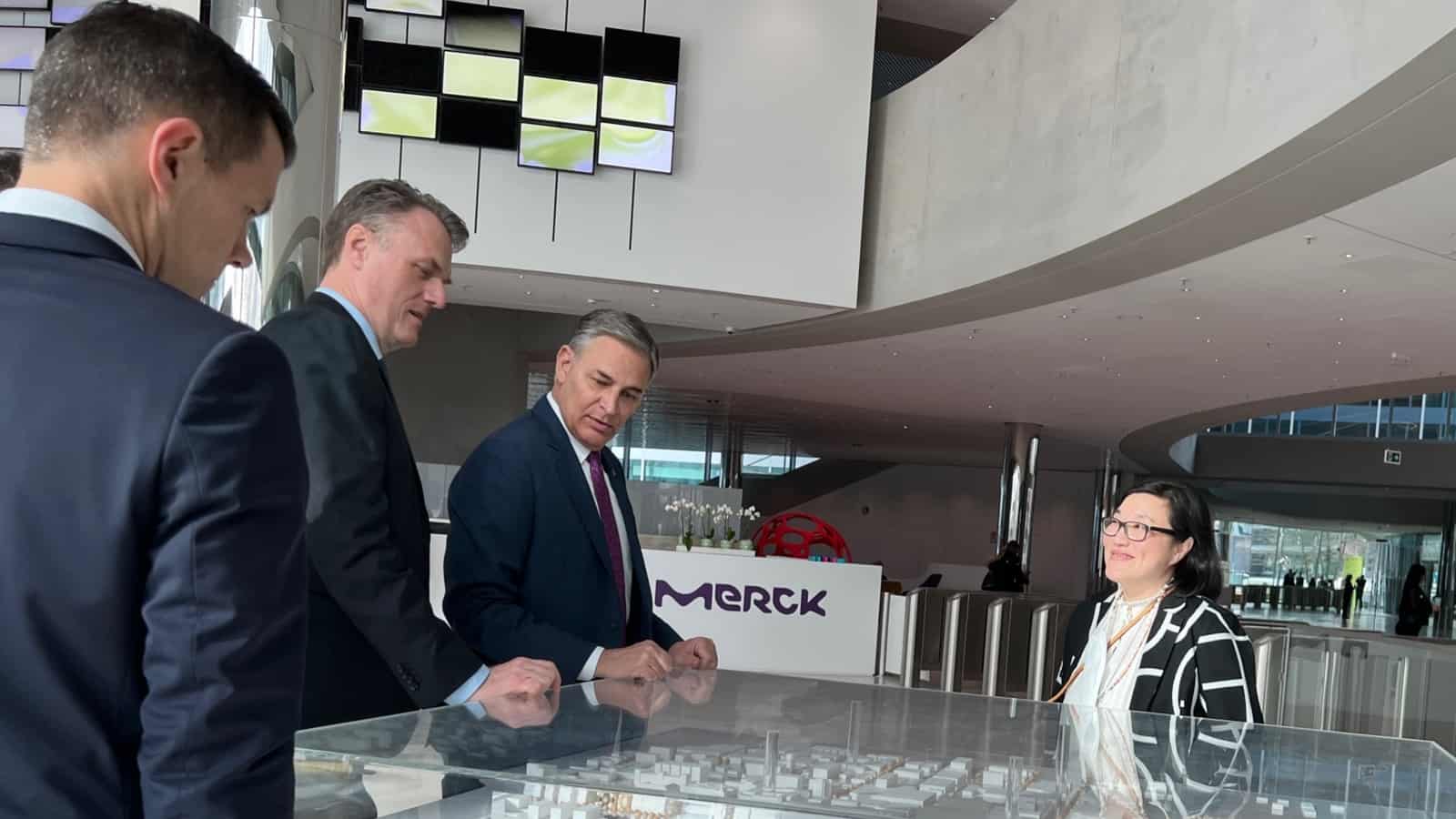
The NAM’s Competing to Win Tour in Europe continued with stops at Merck KGaA in Darmstadt and VDMA, the association of Germany’s engineering industry, in Frankfurt. The visit to Merck KGaA provided a firsthand look at the leadership, culture and operations that are producing about 300,000 products and that played an instrumental role in saving the world from the pandemic.
Living its values: Merck KGaA and its science and technology entities have 60,000 employees around the globe, with approximately 26,000 employees in 66 countries outside of Germany, including the U.S. Its products appear not only in healthcare settings, but in grocery stores where they ensure food and beverages are safe and in transportation where they monitor the air we breathe.
- Matthias Heinzel, CEO of the Merck KGaA Life Science business, and Thaddeus Burns, head of government and public affairs, welcomed the tour and provided insights into the company’s operations.
- The tour of the Merck Innovation Center showcased the company’s state-of-the-art design and technology, while the visit to the growing Membrane operations gave the tour group an opportunity to explore the latest developments.
- A brief stop in the company’s museum provided a historical perspective on the origins of the company, which was founded by the Merck family and began with a small pharmacy named Angel that is still in business today.
VDMA: The tour group also visited VDMA, the association of Germany’s engineering industry, which represents more than 3,300 companies in the sector and focuses on the advancement of trade opportunities.
The last word: The visit to Merck KGaA in Darmstadt underscored the importance of interconnectedness between the U.S. and Europe. It highlighted the vital role alliances play in strengthening enterprises that are essential to our democratic way of life and its protection worldwide.
- “Merck KGaA is a company that lives its values and is a strong champion of free enterprise, competitiveness, individual liberty and equal opportunity, putting its aspirations into action,” said NAM President and CEO Jay Timmons.
The NAM Tours World’s Largest Chemical Complex
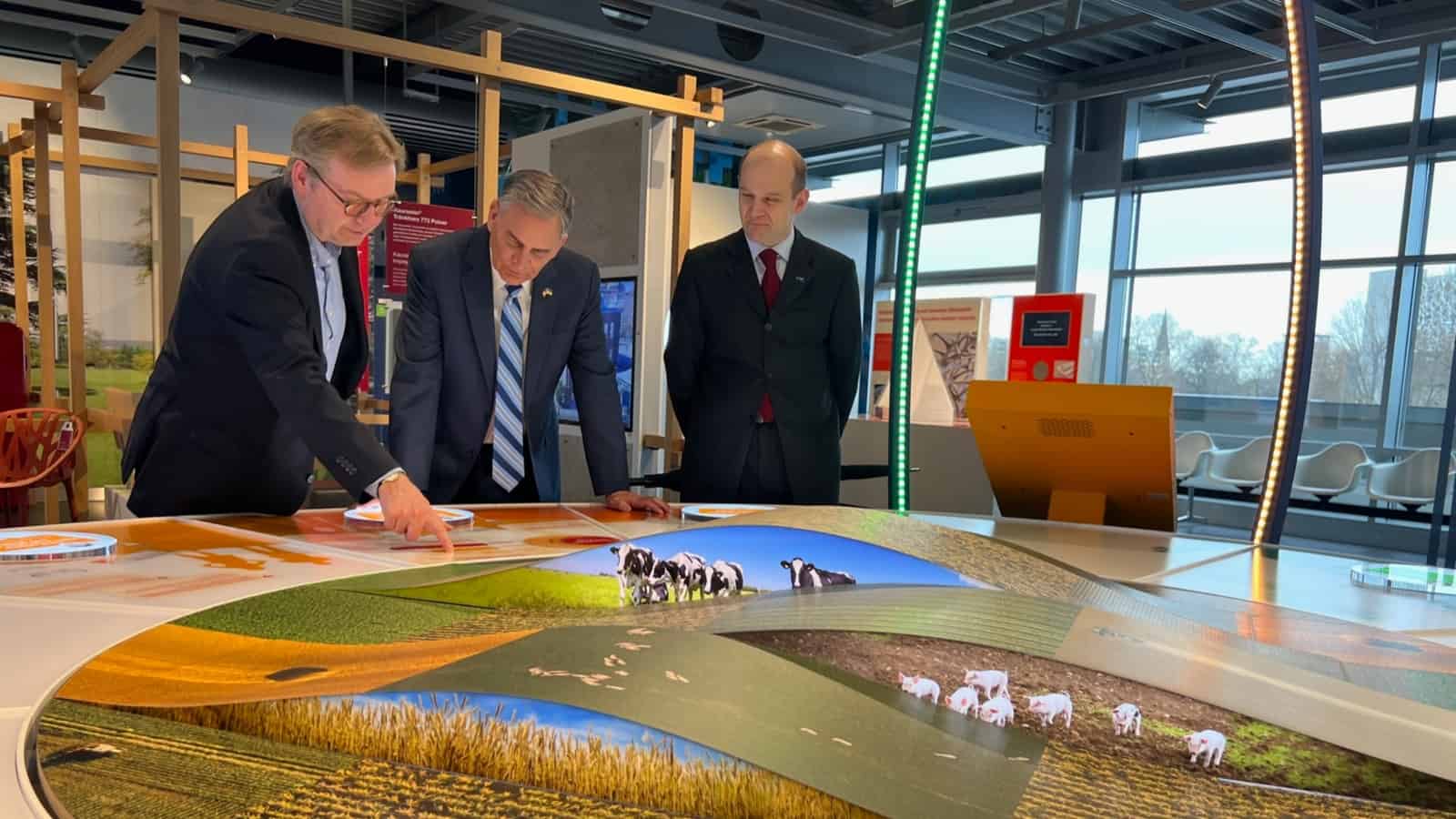
As part of the Competing to Win Tour in Europe, NAM President and CEO Jay Timmons visited the world’s largest integrated chemical complex and the headquarters of BASF in Ludwigshafen, Germany, this week. The visit highlighted how BASF is addressing global challenges and providing a powerful example of manufacturers’ leadership.
BASF in North America: BASF employs more than 16,000 workers in North America. Its facilities include large, integrated, production-energy flow-logistics operations in Geismar, Louisiana, and Freeport, Texas.
- Led by BASF North America President and NAM board member Tobias Dratt, the company has been a strong supporter of the initiatives of the Manufacturing Institute, the NAM’s 501(c)3 workforce development and education affiliate, to build the workforce of the future.
- This includes the Creators Wanted campaign, which aims to inspire the next generation of manufacturers and help companies source talent.
- BASF was among the first companies to advance the NAM and MI’s “This Is Our Shot” Project to increase awareness about COVID-19 vaccinations.
The visit: Timmons met with company leaders forging a path to the future.
- These included BASF Global Business Services President Marc Ehrhardt and Chief Technology Officer and Board of Executive Directors member Dr. Melanie Maas-Brunner.
- Timmons also had the opportunity to take part in a BASF immersive experience, one of the company’s innovative approaches to building community awareness about its impact and the promise of the chemistry industry.
The last word: “To fortify the global economy and strengthen the values of free enterprise, competitiveness, individual liberty and equal opportunity—as well as the capacity for democracy to raise standards of living here at home and around the globe—it’s going to take action in the U.S. and Europe,” Timmons said after the visit.
- “Policymakers must continue boosting supply chain resiliency, energy security and regulatory certainty. The decisions that leaders on both sides of the Atlantic make will determine whether companies like BASF can continue to grow, invest and innovate for a better life for all.”
AB InBev Uses Smart Manufacturing for Award-Winning Results
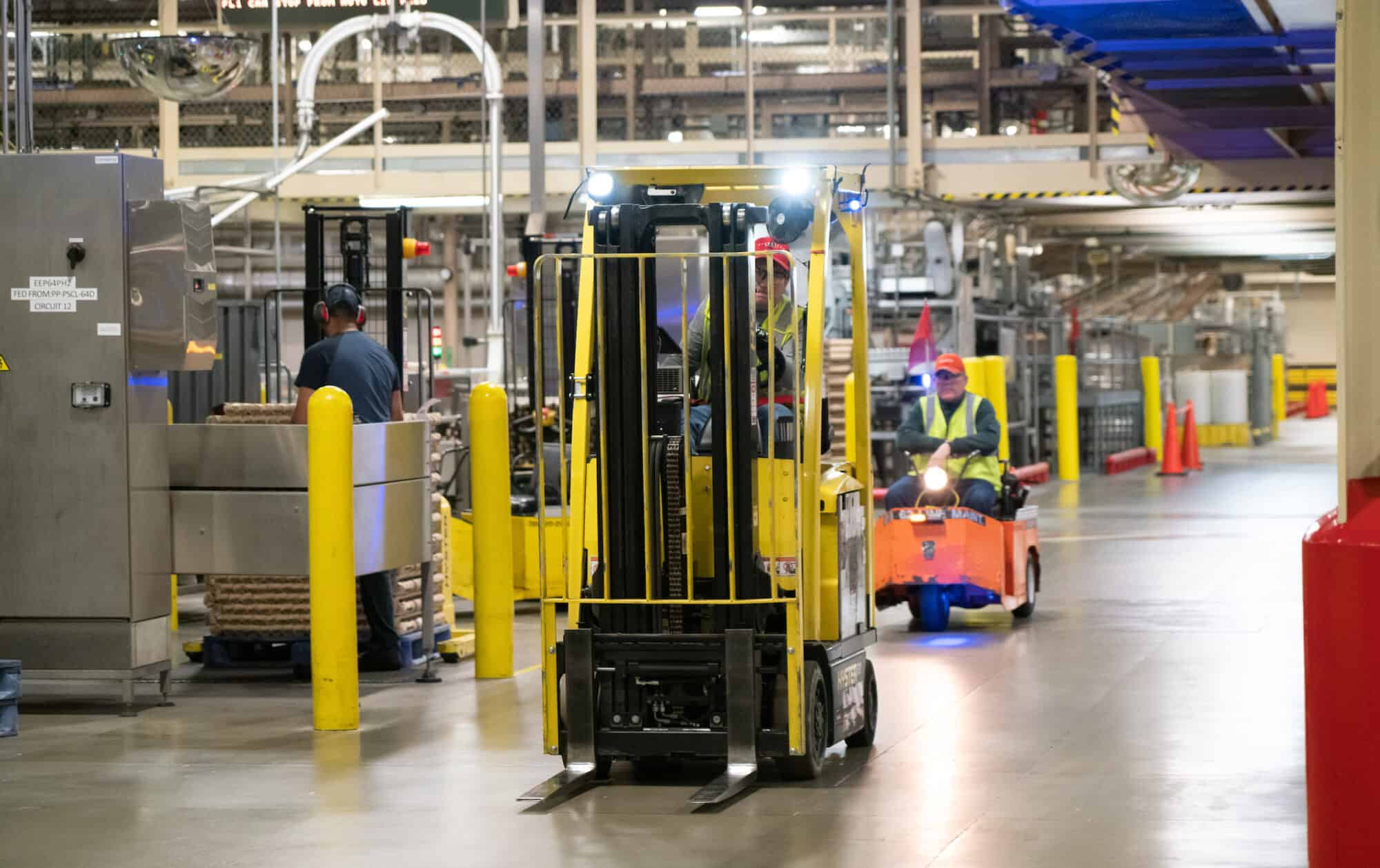
What does it take to be a digital transformation champion? Anheuser-Busch InBev can tell you.
The world’s largest brewer won four Manufacturing Leadership Awards in 2022, including the highly coveted Manufacturer of the Year. (The honors are given annually by the Manufacturing Leadership Council, the NAM’s digital transformation arm.) The MLC chatted with AB InBev Global Vice President Marcelo Ribeiro recently to get his insights on the processes, technologies and strategies driving the company’s success.
Business transformation drivers: “We have a dream at ABI, which is ‘to create a future with more cheers,’” said Ribeiro. “[That means] a clear strategy to lead and grow, to digitize and monetize our ecosystem and to optimize our business.” Here are a few ways AB InBev is pursuing that dream:
- Developing and delivering products that give consumers what they want, when they want it
- Making sure the supply chain can adapt quickly to consumer needs
- Increasing capacity without compromising safety, quality or sustainability
Rising to challenges: “The future is becoming less predictable,” Ribeiro said. “We need to prepare for that, so we have to build a more resilient, flexible supply chain.” Additional opportunities include:
- Moving from transactional relationships with vendors and suppliers to partnerships
- Looking beyond operations and across the entire supply chain to meet sustainability goals
- Creating a collaborative manufacturing ecosystem that fosters the sharing of ideas
Meeting the digital future: Ribeiro says that ABI’s digital strategy has three key aspects:
- Making data more accessible and available to frontline workers
- Creating a template for digital technology that can be easily tailored to the unique needs of each business
- Using advanced analytics to contextualize data and discover where it can best be applied to aid decision making
Leaders required: Ribeiro noted that leadership is essential for making this vision a reality.
- “It is critical to empower the front line,” he said. “Leaders should be focused on providing the resources to allow people to do the work and achieve excellence themselves. In the end, people are key for any business transformation.”
Find additional insights into AB InBev’s digital transformation in DIALOGUE: AB InBev’s Award-Winning Dream, or make plans to attend Rethink, where Ribeiro will present a keynote address on “Building Your Enterprise into a Digital Transformation Champion.”
E-Cycling Helps Manufacturers Generate Business Value

Electronic waste is a big problem.
In 2019, the world generated a record 53.6 million metric tons of discarded electronic and electrical devices, according to a Global E-waste Monitor report. That’s an increase of 21% in just five years. But there’s more: The figure is expected to double by 2050, hitting 120 million tons annually.
The good news is that manufacturers can be an active part of the solution. Though their bread and butter has typically been bringing new products to market, manufacturers are now also developing end-of-life processes for goods to mitigate environmental impact, according to Bright Machines Vice President of Industrial Solutions Adam Montoya, writing in the Manufacturing Leadership Council’s Manufacturing Leadership Journal. (The MLC is the digital transformation division of the NAM).
The challenge: complex components. Disassembling a product is not nearly as straightforward as assembling it, according to Montoya. Take a server, for example. A company might know what’s inside it based on its original configuration, but memory or processor upgrades could have changed over the course of its life.
- When a lot of change has taken place, the dismantling process is unique to each server, making it complex and difficult to automate.
The solution: intelligent disassembly. Improving the end-of-life process for electronics requires intelligent disassembly, a combination of smart technology and a different way of thinking, says Montoya. Here’s how it works:
- Automation technology that uses AI and advanced vision systems interprets the contents of a particular component and compares it against the original blueprint.
- Next, the system assesses the presence and location of components within the unit.
- It then sorts, separates and removes components so they can be reclaimed or recycled.
The bottom line: Manufacturers stand to realize many benefits from intelligent disassembly. Components with sensitive data can have machine-driven proof of destruction. Systems with usable parts can be repurposed rapidly.
- Ultimately, it’s an important way for manufacturers to collectively reduce carbon footprints and electronic waste while delivering business value, says Montoya.
For more on this topic, read Rethinking End-of-Life Technology Value in the Manufacturing Leadership Journal. And to learn more about how manufacturing leaders are undertaking digital transformations, join the MLC at its Rethink conference in Marco Island, Florida, on June 26–28.
Manufacturers Lend a Hand in Turkey, Syria
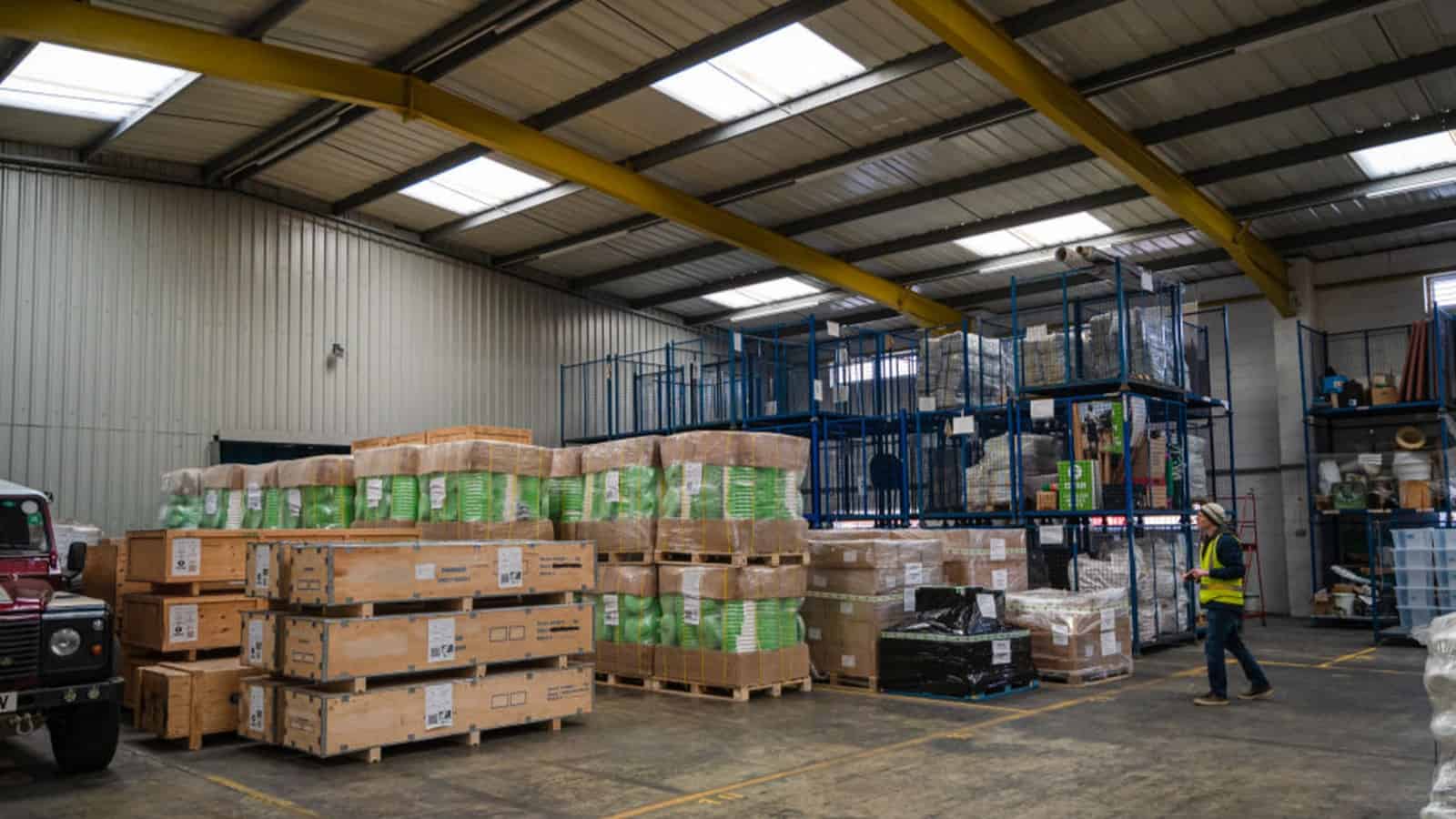
It’s been nearly a month since a devastating earthquake hit Turkey and Syria, killing at least 50,000 people—but manufacturers haven’t stopped lending a hand.
What’s going on: Through NAM Emergency Response Committee partners Project HOPE and Good 360, as well as other avenues, manufacturers in the U.S. were among the first to offer supplies and services to survivors. Here is just a sampling of the aid they provided.
Transport help: Manufacturers in the logistics sector stepped up to help ship necessary goods and supplies.
- The UPS Foundation has committed $1 million in global logistics support and employee-contributions matches.
- FedEx has committed more than $1 million of in-kind shipping so far.
Funds: Others are giving sizable monetary donations to the relief efforts.
- The Caterpillar Foundation is donating $400,000 to support relief efforts.
- Boeing Charitable Trust is giving a $500,000 donation.
- Novartis is donating $1 million.
- Rockwell Automation is donating $50,000 to the American Red Cross.
- Siemens has donated more than $1 million.
Supplies: Many manufacturers have also been donating much-needed goods to the earthquake victims.
- In addition to donating $1.2 million, the PepsiCo Foundation has partnered with nonprofits Tider and Ahbap to deliver essentials, including food, water, sanitation and hygiene products, along with container shelters, blankets and other emergency supplies.
- The Kraft Heinz Foundation is sending food and care products and donating $500,000 to the Red Cross.
- The Abbott Fund has committed $1.5 million in grants and product donations.
How to help: If you’d like to help those in need in Turkey and Syria, the NAM Emergency Response Committee offers options:
- To donate needed products—including hygiene kits, cold-weather clothing or health supplies—please visit Good360’s goods-donation page.
- If you want to give funds to support humanitarian relief, you can do so via the NAM’s partnership with Project HOPE.
Share your story: The NAM Emergency Response Committee is looking to hear from manufacturers about how they may have been affected by the earthquake and how they may be helping. To share your stories, please contact the NAM Emergency Response Committee at [email protected].
Modine Keeps the Digital Economy Cool and Functional
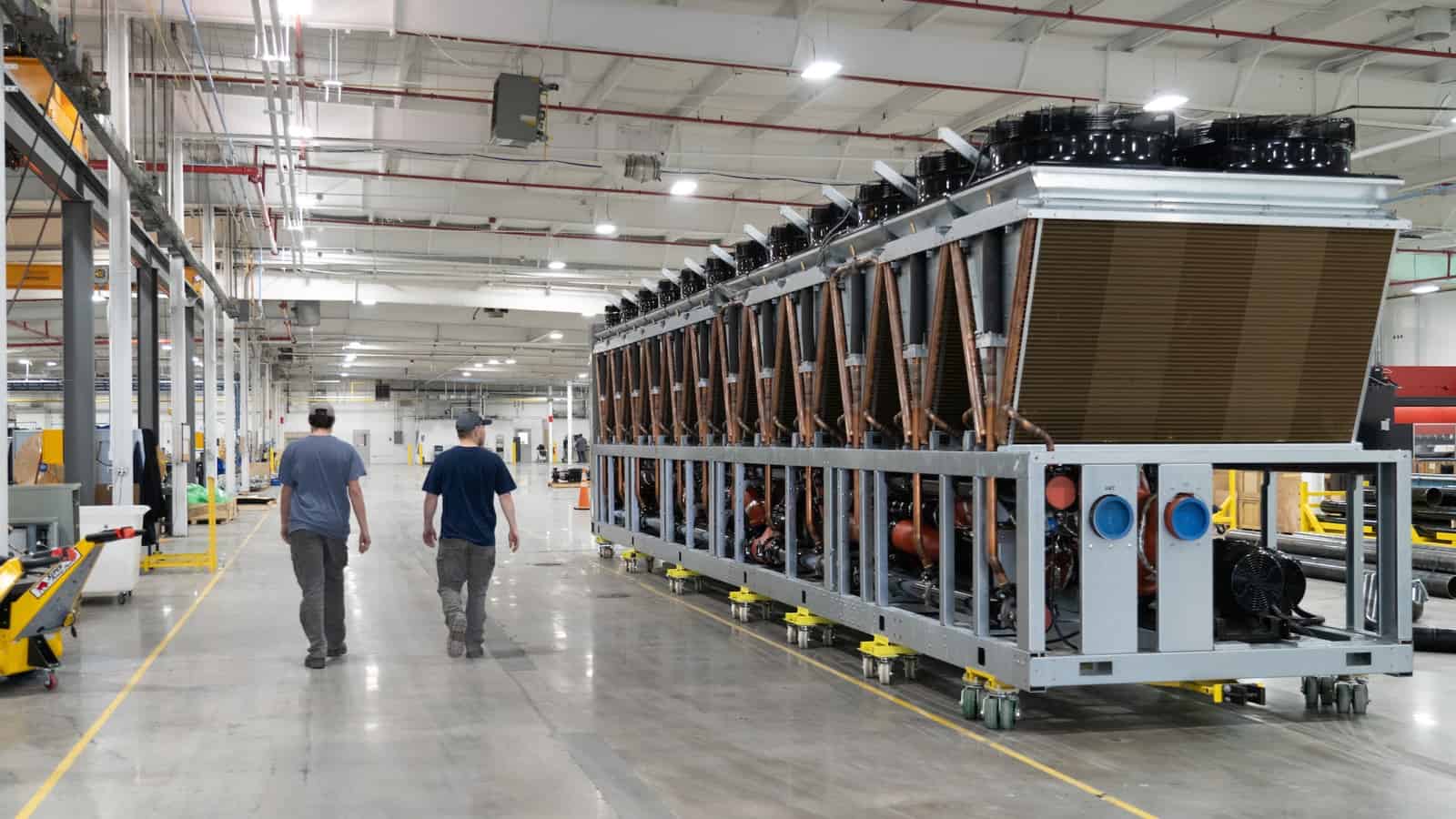
Here’s the secret ingredient in the digital economy: data center chillers. All those enormous data centers that keep track of your bank account, work emails and lunch orders get very hot, requiring state-of-the-art cooling technology to keep them functional and efficient.
We recently got to see how these enormous machines are made, courtesy of Modine Manufacturing, which opened its first data center chiller production plant in Rockbridge, Virginia, back in November. NAM Senior Director of Photography David Bohrer captured the production line in action, while several of Modine’s leaders spoke to the NAM at a later date about the technology involved.
Why chillers? The demand for data center chillers rises with the demand for data, which seems to be pretty much endless nowadays.
- As Darren Farrar, Modine’s global head of marketing for data centers, explained, “Data centers are always on; they are constantly processing data and therefore producing heat. They use a lot of energy, so any incremental improvements we can make [in cooling technology] can make a lot of difference to energy bills.”
- That’s where Modine comes in. Though chillers have been around since the 1920s, the needs of the digital economy mean that further innovation and specialization are always necessary.
How it works: A chiller provides cool water to the data center building while removing the heat that is returned from it, in an endless cycle.
- Modine’s chillers have two circuits, one of which uses outdoor air to chill the water, in a process called “free cooling,” explained Rob Bedard, general manager of data centers, North America. It’s a method that provides considerable energy savings.
- The chiller also has a “classical” refrigeration circuit for when outdoor temperatures aren’t helpful. Last, fans on top of the unit vent heat away from the building.
How it’s made: The Rockbridge plant is Modine’s first data center chiller plant in the U.S. and is situated in Virginia due to the state’s high concentration of data centers, said Bedard. The facility is “purpose-designed” for production, and everything is done on site:
- Technicians cut the parts from raw materials, then add refrigeration, suction and the distinctive V-shaped pipes for coolant, explained Tommy Johnson, Rockbridge’s plant manager.
- The assembly line checks the pressure, ensures there are no leaks and does final testing, he added. The facility even hosts demonstrations for customers in a state-of-the-art test lab, so they know what they’re getting.
Here a team constructs the metal frame of the chiller and adds insulation to the copper pipework and heat exchangers that carry the refrigerant:
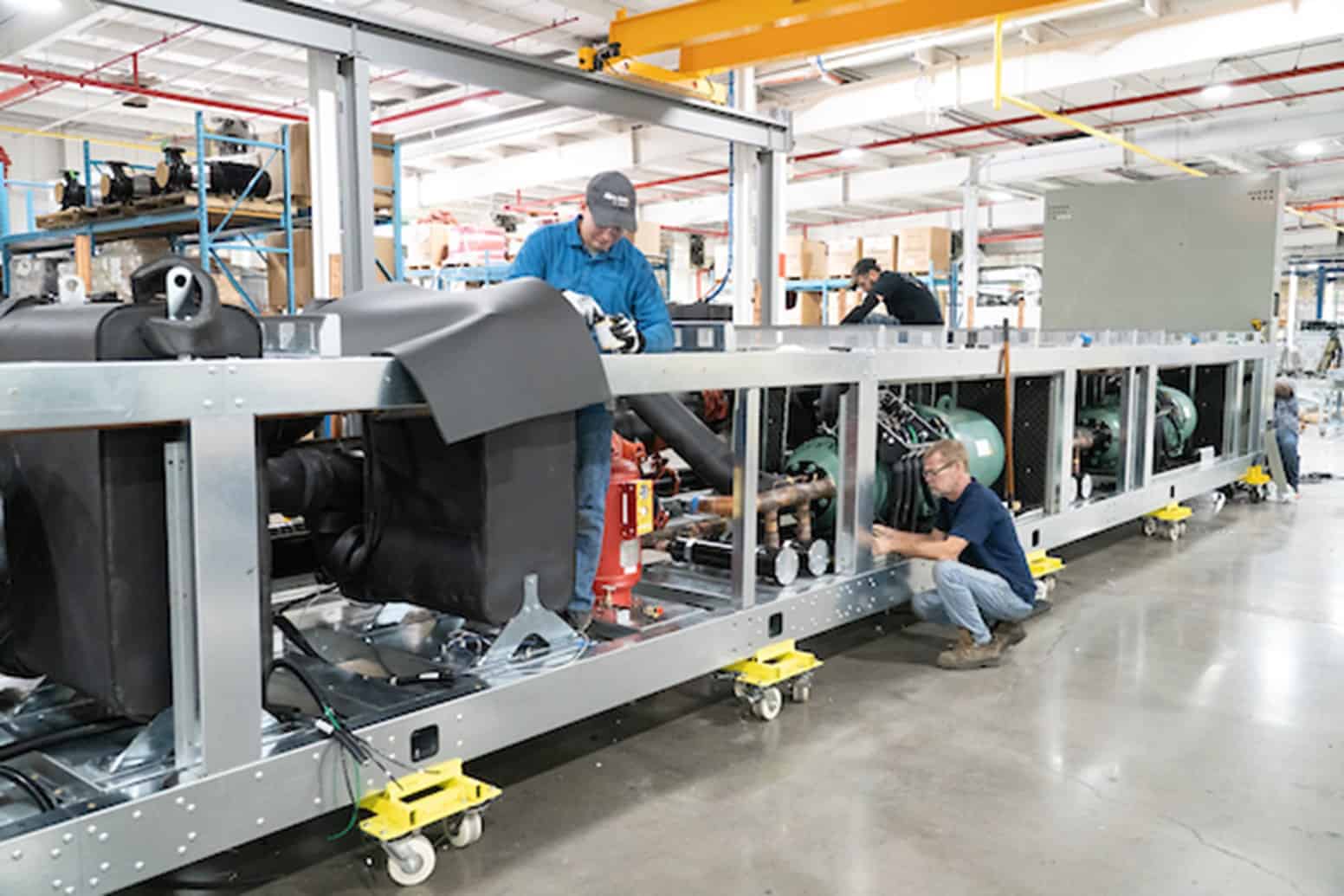
Another technician installs the massive fans on top of the structure, which draw air through the huge V-shaped heat exchangers, removing the heat and venting it upward:
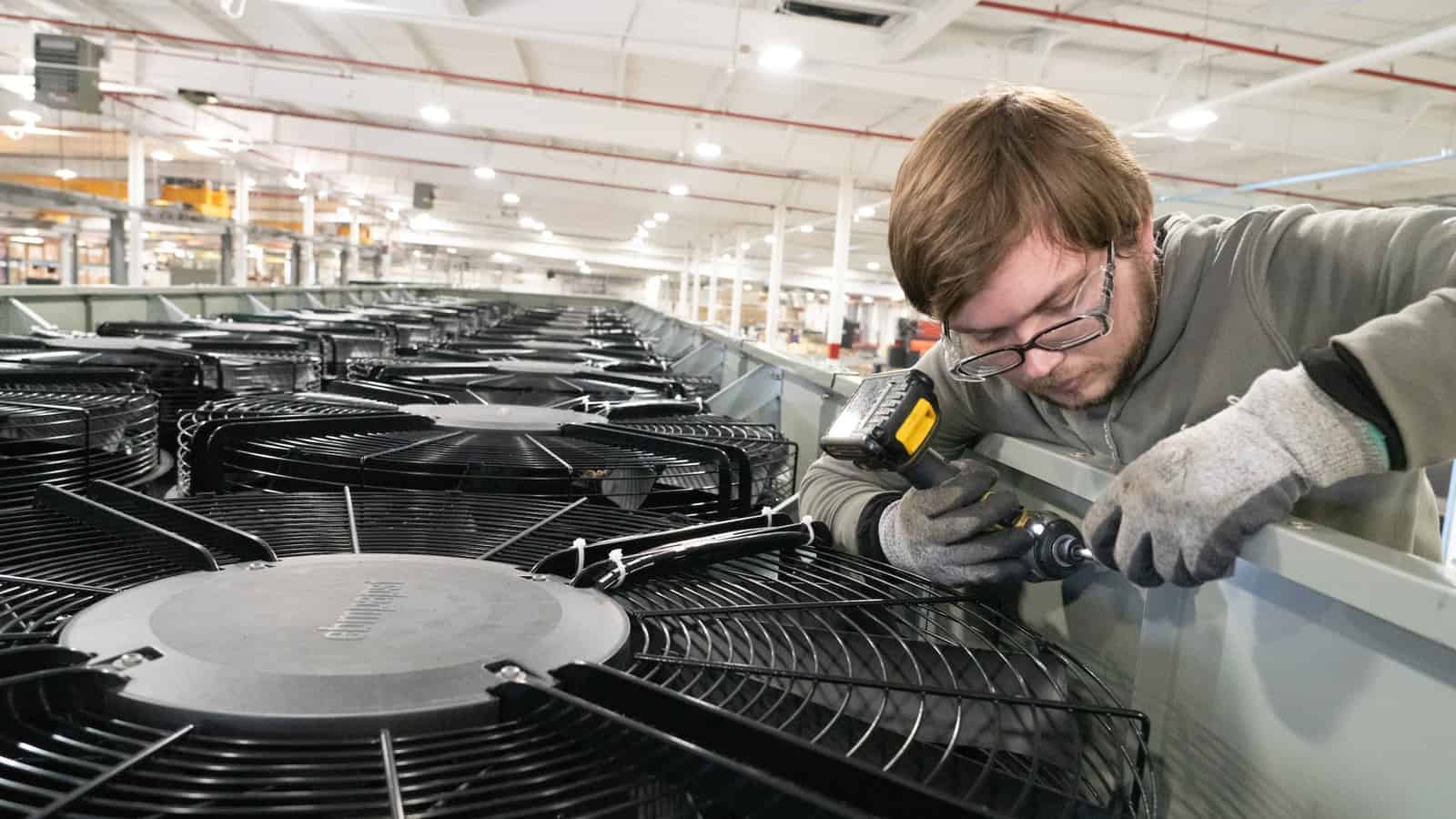
These copper pipes circulate water through the unit:
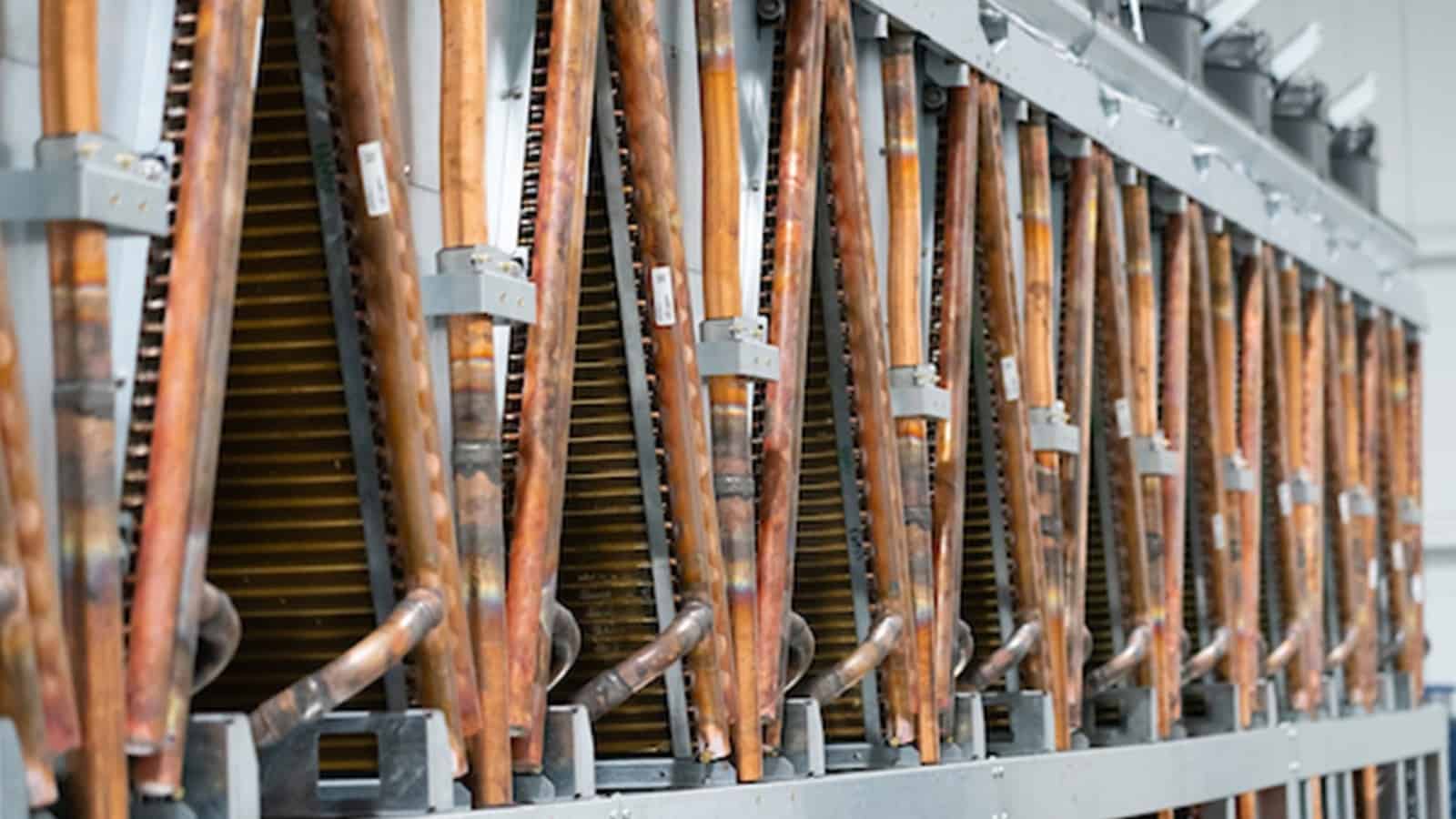
And last, here is the nearly finished chiller, which stands an impressive 10.1 feet tall, 45.6 feet long and 7.8 feet wide:
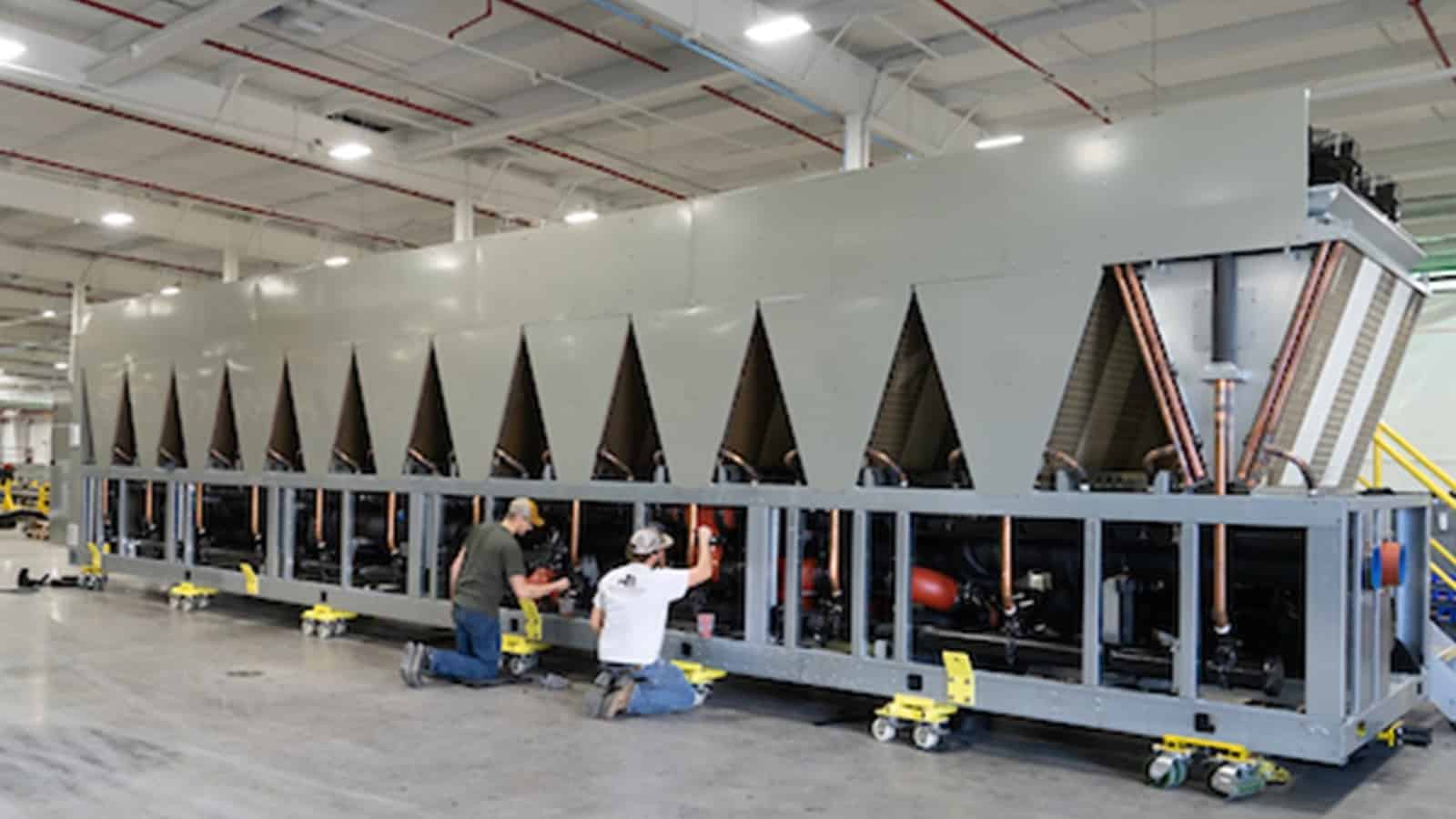
What’s next: What does Modine predict for the future of this market?
- “As big IT companies develop high-density chips,” Farrar said, “existing data centers will only become more powerful—and thus hotter.” Meanwhile, the increasing use of AI and cryptocurrency will also lead to greater demand for data centers.
- In addition, sustainability will only become more of a priority. As Farrar put it, the data chiller industry will have to learn to grow sustainably throughout its supply chain—by using fewer and greener refrigerants, reducing water and carbon usage and more.
- Modine plans to meet these challenges with its newly commissioned testing center at the Rockbridge facility, where it will do all its own testing and validation for the North American market, Farrar said.
Off to a great start: Today, Modine is confident and optimistic, having recently delivered Rockbridge’s first batch of chillers to a Corescale data center in Gainesville Crossing, Virginia. It was “the culmination of all our efforts for a 2-year period,” said Farrar—a real “red letter day.”
